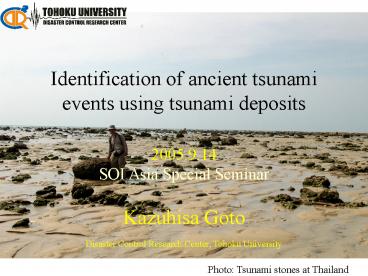Identification of ancient tsunami events using tsunami deposits - PowerPoint PPT Presentation
1 / 34
Title: Identification of ancient tsunami events using tsunami deposits
1
Identification of ancient tsunami events using
tsunami deposits
2005.9.14SOI Asia Special Seminar
Kazuhisa Goto
Disaster Control Research Center, Tohoku
University
Photo Tsunami stones at Thailand
2
Contents of todays talk
?How can we know the recurrence interval
of tsunami?
? Identification of ancient tsunami events
Ancient documents Tsunami deposits
(stones) ? How can we recognize tsunami deposits?
3
What should we do against the tsunami disaster?
1. Before the tsunami generation Prediction
of next tsunami event (date and magnitude)
Establishment of tsunami warning system
Education for the disaster-prevention
4
How can we predict the next tsunami event?
How can we know the recurrence interval of
tsunami events?
If we can identify ancient tsunami events, we may
understand the recurrence interval of tsunami
events.
This idea is applied to estimate the recurrence
intervals of earthquake, volcanic activity
5
1. Ancient documents ? Precise date, effect
and approximate magnitude of tsunamis are
recorded.
6
Rupture zone
Keityou earthquake (M 7.9)
102 year
The records are depending on the history of
your country. We cant get information of
pre-history age.
Houei earthquake (M 8.4)
147 year
Ansei-Tokai earthquake (M 8.4)
90 year
Tounankai earthquake (M 7.9)
Nankai earthquake (M 8.0)
151 year
Nankai
Tounankai
Modified the figure provided by Dr. Abe (Univ.
Tokyo)
7
2. Tsunami deposits (stones)
Sea
Tsunami deposit in Sri Lanka
Tsunami erodes and transports the sea bottom
sediment particles (soil, sand, rock).
8
(No Transcript)
9
Records of ancient tsunami events are in the
bottoms of land, lake and sea!
Indian Ocean tsunami
Tsunami invasion
Lake
Lake sediments
Past Indian Ocean tsunami deposits
10
2. Tsunami deposits (stones)
? You can get information of ancient tsunami
events from 4 billion (4,000,000,000) years ago
(origin of the ocean) !!!
11
Presence of marine planktons
marine planktons
Plankton A
Plankton B
Plankton C
Plankton D
Plankton E
Plankton F
Plankton G
They are living in their preferable (specific)
water depth.
Terrestrial materials (plant debris)
12
Upward fining layers
http//kagi.coe21.kyoto-u.ac.jp/jp/observation/200
4/20050330-0000_b0003.jpg
13
Sedimentary structures reflecting influence of
currents
Cross lamination
14
Cross lamination the case of tsunami
Bi-directional cross lamination
15
(No Transcript)
16
Takada et al. (2002)
17
Topic 1 The Cretaceous/Tertiary boundary
asteroid impact event
-The Cretaceous/Tertiary (K/T) boundary-
?65 million years ago
?Dinosaurs extinction ?Large
asteroid impact
Photo NASA
18
Discovery of impact crater in the Yucatan
peninsula, Mexico
Hildebrand et al. (1991)
180 km in diameter
http//www.lpl.arizona.edu/SIC/impact_cratering/Ch
icxulub/Chicx_title.html
19
K/T boundary impact was an oceanic impact
Paleogeographic map at 65 million years ago
The depth of impact site was 200 m
Giant tsunami could have generated by the impact
20
?????,???????????K/T???
Distribution of tsunami deposits around the
impact site
Brazos River
0
200 km
200
390A1049
1000
2000
Ramones
Tecolote
Penon
Multo
3000
Lajila
Mimbral
97
540
537
200
1000
2000
Havana
3000
536
Soroa
Chicxulub crater
Pinar del Rio
Ceiba
Campeche
Albion Island
Guayal
1001
Goto et al. (submitted)
21
Presence of tsunami deposits in Cuba, Mexico, USA
Deep sea tsunami deposit
Debris flow deposit
50 m
Tsunami deposit in Cuba (more than 200 m in
thickness)
Influence of impact tsunami was reached 2000 m
water depth(Takayama et al., 2000 Tada et al.,
2004 Goto et al., submitted)
Goto et al. (submitted)
22
Tsunami generation mechanism at the K/T boundary
Goto et al. (2004)
Impact site
age
Sea water
(a)
Yucatan Platform
(Ma)
Suspended ocean bottom sediments
Melt fragment/ shocked quartz
Ejecta deposit
Ocean water invasion
(b)
Crater cavity
Overflow of water
Chicxulub drilling core (YAX-1)
(c)
Impactite
(d)
(e)
Older sediments
Younger sediments
23
Wave height of tsunami around the impact site
Chicxulub crater
Period 10 hours, Wave height 300 m
Imamura et al. (1999), Matsui et al. (2002)
24
2. Tsunami deposits (stones)
The study of tsunami deposits have started
mainly from 1990s. It is difficult to
estimate magnitude of tsunami from tsunami
deposits
until the Indian Ocean tsunami event
The Indian Ocean tsunami formed tsunami deposits.
The magnitude of The Indian Ocean tsunami has
been understood. ?we may understand the relation
between the tsunami magnitude and formation of
tsunami deposits.
25
Measurement of tsunami wave height
Khao Lak, Thailand
26
Erosion of beach sands by tsunami waves
Khao Lak, Thailand
27
Distribution of Indian Ocean tsunami deposits
Bang Sak beach, Thailand
Transect A
Boat
blocks
100 m
Goto et al. (submitted)
28
Goto et al. (submitted)
29
A1 40 m away from the shoreline
Landward bended grasses
Goto et al. (submitted)
30
A1 40 m away from the shoreline
Goto et al. (submitted)
31
A1 Grain composition
Goto et al. (submitted)
32
Tsunami stones
Pakarang (coral reef) Cape, Thailand
Goto et al. (submitted)
33
Tsunami stone can be recognized from satellite
http//www.globalsecurity.org/military/world/thail
and/khaolak.htm
34
Summary
Recurrence interval of tsunami is important to
estimate the occurrence of next tsunami.
Ancient documents and tsunami deposits are useful
for understanding the recurrence interval of
tsunamis.































